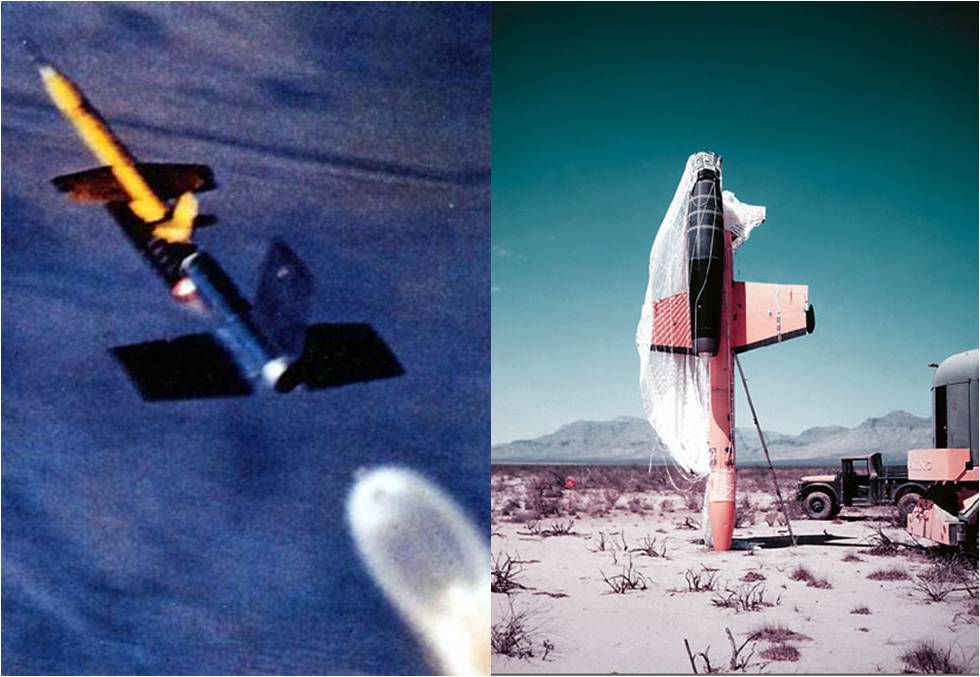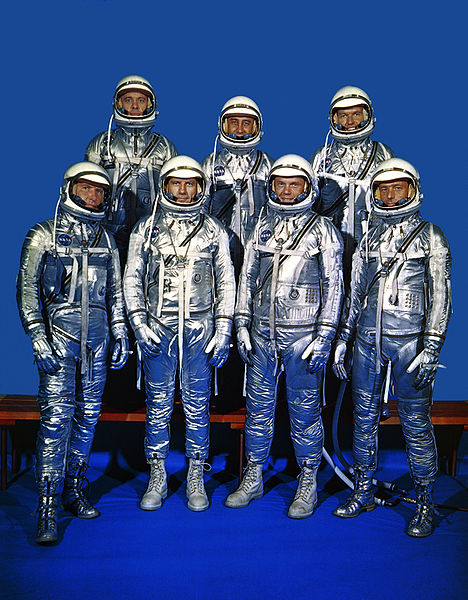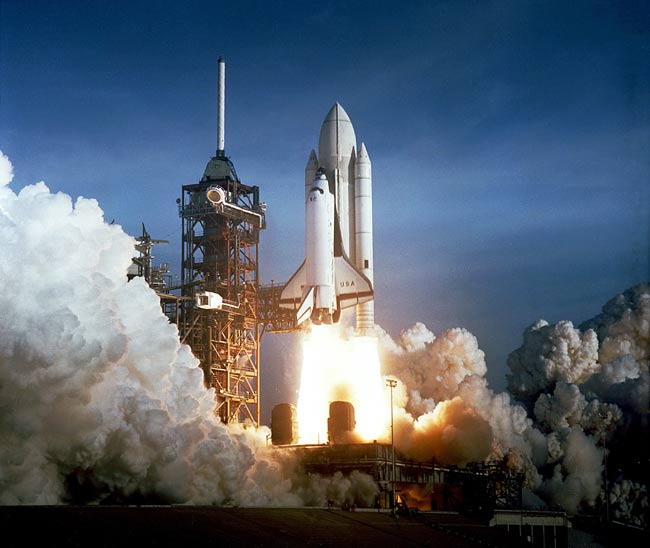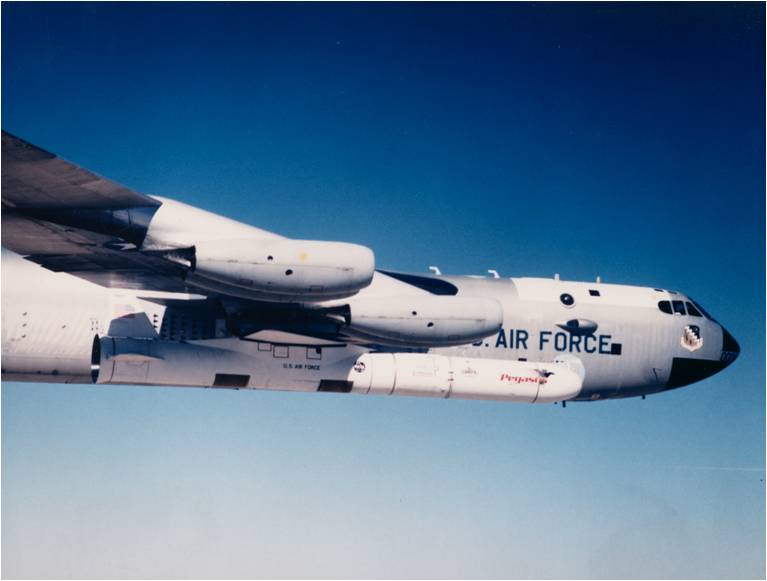
Fifty-nine years ago today, the first flight test of a full-scale Lockheed X-7A ramjet test vehicle took place near Alamogordo, New Mexico. However, the dreaded flight test gremlins prevailed on this occasion as the entire X-7 launch stack disintegrated shortly after drop from its USAF B-29 launch aircraft.
The inauspicious start to the X-7 flight test program on Thursday, 26 April 1951 was but a momentary bump in the road. Ultimately, that road would lead to significant technological progress in the development of ramjet propulsion systems. Approximately 130 flight tests involving the X-7 would be conducted between 1951 and 1960.
The beginning of the X-7 program dates back to December of 1946. At that time, the United States was on the cusp of an unprecedented period of frontiersmanship in the realm of high-speed flight. Among other needs, a flying testbed was required to perform ramjet propulsion flight research.
A ramjet is a form of airbreathing propulsion well suited for flight up to a Mach number of about 5. Unlike the turbojet, a ramjet contains no internal rotating machinery. Flow compression comes entirely from deceleration of the supersonic freestream. However, a ramjet cannot produce static thrust. Hence, it must be boosted to flight speed via another propulsion system such as a turbojet or rocket.
The X-7 was rocket-boosted to ramjet take-over conditions. Booster thrust was on the order of 100,000 pounds with a burn time of 5 seconds. Following booster separation, the type would fly on ramjet power until fuel exhaustion. The ramjet test article was slung under the belly of the X-7 airframe which made for an asymmetric vehicle configuration.
The entire X-7A-1 launch stack measured almost 33 feet in length and had a gross weight of about 8,000 pounds. Later variants such as the X-7A-3 and XQ-5 would be longer by 3 and 4 feet, respectively. However, their gross weight was about the same as that of the X-7A-1 configuration.
The X-7 was designed for reusability. Vehicle recovery was effected via a multi-segment parachute system. This feature afforded engineers the unique opportunity to make a post-flight inspection of each ramjet engine test article. These inspections of flight hardware made for a more reliable means of making needed propulsion system design improvements.
Typically, the X-7’s long conical nose penetrated several feet into the soil at landing. The result was that the X-7 airframe stuck out of the ground with the main parachute usually draped over the vehicle’s aft end. This somewhat comical operational feature made the X-7 much easier to locate on the floor of the vast desert test range.
The X-7 was utilized to flight test ramjet engines that ranged from 20 to 36 inches in diameter. Key propulsion performance data were telemetered to ground stations for post-flight analysis. The ability to test an assortment of ramjet engine configurations during many flights produced a wealth of ramjet propulsion data over the life of the X-7 program.
The X-7 established a variety of flight performance records during its heyday. The type’s airbreathing propulsion speed, altitude and range records included 2,880 mph (Mach 4.3), 106,000 feet and 134 miles, respectively. Note that these marks were all accomplished in the 1950’s.
The technological legacy of the X-7 program is impressive. Indeed, flight vehicles such as the Boeing BOMARC, Lockheed SR-71 and Lockheed D-21 were direct beneficiaries of X-7 propulsion flight research. Though difficult to assess the extent thereof, Lockheed’s legendary Advanced Development Program (i.e., Skunk Works) has undoubtably benefitted from the X-7’s rich propulsion legacy as well.

Fifty-one years ago this month, NASA held a press conference in Washington, D.C. to introduce the seven men selected to be Project Mercury Astronauts. They would become known as the Mercury Seven or Original Seven.
Project Mercury was America’s first manned spaceflight program. The overall objective of Project Mercury was to place a manned spacecraft in Earth orbit and bring both man and machine safely home. Project Mercury ran from 1959 to 1963.
The men who would ultimately become Mercury Astronauts were among a group of 508 military test pilots originally considered by NASA for the new role of astronaut. The group of 508 candidates was then successively pared to 110, then 69 and finally to 32. These 32 volunteers were then subjected to exhaustive medical and psychological testing.
A total of 18 men were still under consideration for the astronaut role at the conclusion of the demanding test period. Now came the hard part for NASA. Each of the 18 finalists was truly outstanding and would be a worthy finalist. But there were only 7 spots on the team.
On Thursday, 09 April 1959, NASA publicly introduced the Mercury Seven in a special press conference held for this purpose at the Dolley Madison House in Washington, D.C. The men introduced to the Nation that day will forever hold the distinction of being the first official group of American astronauts. In the order in which they flew, the Mercury Seven were:
Alan Bartlett Shepard Jr., United States Navy. Shepard flew the first Mercury sub-orbital mission (MR-3) on Friday, 05 May 1961. He was also the only Mercury astronaut to walk on the Moon. Shepherd did so as Commander of Apollo 14 (AS-509) in February 1971. Alan Shepard died from leukemia on 21 July 1998 at the age of 74.
Vigil Ivan Grissom, United States Air Force. Grissom flew the second Mercury sub-orbital mission (MR-4) on Friday, 21 July 1961. He was also Commander of the first Gemini mission (GT-3) in March 1965. Gus Grissom might very well have been the first man to walk on the Moon. But he died in the Apollo 1 Fire, along with Astronauts Edward H. White II and Roger Chaffee, on Friday, 27 January 1967. Gus Grissom was 40 at the time of his death.
John Herschel Glenn Jr., United States Marines. Glenn was the first American to orbit the Earth (MA-6) on Thursday, 22 February 1962. He was also the only Mercury Astronaut to fly a Space Shuttle mission. He did so as a member of the STS-95 crew in October of 1998. Glenn was 77 at the time and still holds the distinction of being the oldest person to fly in space. John Glenn will be 89 in July 2010.
Malcolm Scott Carpenter, United States Navy. Carpenter became the second American to orbit the Earth (MA-7) on Thursday, 24 May 1962. This was his only mission in space. Carpenter subsequently turned his attention to under-sea exploration and was an aquanaut on the United States Navy SEALAB II project. Scott Carpenter will be 85 in May 2010.
Walter Marty Schirra Jr., United States Navy. Schirra became the third American to orbit the Earth (MA-8) on Wednesday, 03 October 1962. He later served as Commander of Gemini 6A (GT-6) in December 1965 and Apollo 7 (AS-205) in October 1968. Schirra was the only Mercury Astronaut to fly Mercury, Gemini and Apollo space missions. Wally Schirra died from a heart attack in May 2007 at the age of 84.
Leroy Gordon Cooper Jr., United States Air Force. Cooper became the fourth American to orbit the Earth (MA-9) on Wednesday, 15 May 1963. In doing so, he flew the last and longest Mercury mission (22 orbits, 34 hours). Cooper was also Commander of Gemini 5 (GT-5), the first long-duration Gemini mission, in August 1965. Gordo Cooper died from heart failure in October 2004 at the age of 77.
Donald Kent Slayton, United States Air Force. Slayton was the only Mercury Astronaut to not fly a Mercury mission when he was grounded for heart arrythemia in 1962. He subsequently served many years on Gemini and Apollo as head of astronaut selection. He finally got his chance for spaceflight in July 1975 as a crew member of the Apollo-Soyuz mission (ASTP). Deke Slayton died from brain cancer in June of 1993 at the age of 69.
History records that the Mercury Seven was the only group of NASA astronauts that had a member that flew each of America’s manned spacecraft (i.e, Mercury, Gemini, Apollo and Shuttle). Though just men and imperfect mortals, we salute each of them for their genuinely heroic deeds and unique contributions made to the advancement of American manned spaceflight.

Twenty-nine years ago today, the United States successfully launched the Space Shuttle Columbia into orbit about the Earth. It was the maiden flight of the Nation’s Space Transportation System (STS).
The Space Shuttle was unlike any manned space vehicle ever flown. A giant aircraft known as the Orbiter was side-mounted on a huge liquid-propellant stage called the External Tank (ET). Flanking opposing sides of the ET was a pair of Solid Rocket Boosters (SRB). The Orbiter, SRB’s and ET measured 122 feet, 149 feet and 154 feet in length, respectively.
The Space Shuttle system was conceived with an emphasis on reusability. Each Orbiter (Columbia, Challenger, Atlantis, Discovery and Endeavor) was designed to fly 100 missions. Each SRB was intended for multiple mission use as well. The only single-use element was the ET since it was more cost effective to use a new one for each flight than to recover and refurbish a reusable version.
NASA called STS-1 the boldest test flight in history. Indeed, the STS-1 mission marked the first time that astronauts would fly a space vehicle on its inaugural flight! STS-1 was also the first time that a manned booster system incorporated solid rocket propulsion. Unlike liquid propellant rocket systems, once ignited, the Shuttle’s solid rockets burned until fuel exhaustion.
And then there was the Orbiter element which had its own new and flight-unproven propulsion systems. Namely, the Space Shuttle Main Engines (SSME) and Orbital Maneuvering System (OMS). Each of the three (3) SSME’s generated 375,000 pounds of thrust at sea level. Thrust would increase to 475,000 pounds in vacuum. Each OMS rocket engine produced 6,000 pounds of thrust in vacuum.
The Orbiter was also configured with a reusable thermal protection system (TPS) which consisted of silica tiles and reinforced carbon-carbon material. The TPS for all previous manned space vehicles utilized single-use ablators. Would the new TPS work? How robust would it be in flight? What post-flight care would be needed? Answers would come only through flight.
To add to the “excitement” of first flight, the Orbiter was a winged vehicle and would therefore perform a hypersonic lifting entry. The vehicle energy state would have to be managed perfectly over the 5,000 mile reentry flight path from entry interface to runway touchdown. Since the Orbiter flew an unpowered entry, it would land dead-stick. There would only be one chance to land.
On Sunday,12 April 1981, the Space Shuttle Columbia lifted-off from Pad 39A at Cape Canaveral, Florida. Official launch time was 12:00:03 UTC. The flight crew consisted of Commander John W. Young and Pilot Robert L. Crippen. Their Columbia launch stack tipped the scales at 4.5 million pounds and thundered away from the pad on over 7 million pounds of thrust.
Columbia went through maximum dynamic pressure (606 psf) at Mach 1.06 and 26.5 KFT. SRB separation occurred 120 seconds into flight at Mach 3.88 and 174,000 feet; 10,000 feet higher than predicted. This lofting of the ascent trajectory was later attributed to unmodeled plume-induced aerodynamic effects in the Orbiter and ET base region.
Following separation, Columbia rode the ET to burnout at Mach 21 and 389.7 KFT. Following ET separation, Columbia’s OMS engines were fired minutes later to achieve a velocity of 17,500 mph and a 166-nautical mile orbit.
Young and Crippen would orbit the Earth 37 times before coming home on Tuesday, 14 April 1981. In doing so, they successfully flew the first hypersonic lifting reentry from orbit. Though unaware of it at the time, the crew came very close to catastrophe as the Orbiter’s body flap had to be deflected 8 degrees more than predicted to maintain hypersonic pitch control.
The reason for this “hypersonic anomaly” was that ground test and aero modeling had failed to capture the effects of high temperature gas dynamics on Orbiter pitch aerodynamics. Specifically, the vehicle was more stable in hypersonic flight than had been predicted. This necessitated greater nose-down body flap deflections to trim the vehicle in pitch. It was a close-call. But Columbia and its crew lived to fly another day.
Columbia touched-down at 220 mph on Runway 23 at Edwards Air Force Base, California at 18:20:57 UTC. Young and Crippen were euphoric with the against-the-odds success of the Space Shuttle’s first mission.
NASA too reveled in the Shuttle’s accomplishment. And so did America. This was the country’s first manned space mission since 1975. The longest period of manned spaceflight inactivity ever in the Nation’s history.
Fittingly, a well-known national news magazine celebrated Columbia’s success with a headline which read: “America is Back!”
And while it flies no more, we remember that first Orbiter, its first flight and its many subsequent accomplishments. To which we say: Hail Columbia!

Twenty-years ago today, the Orbital Sciences Corporation (OSC) orbited a PegSat satellite using the then-new Pegasus 3-stage launch vehicle. This historic event marked the first successful implementation of the air-launched satellite launcher concept.
The concept of air-launch dates back to the 1940’s and the early days of United States X-plane flight research. A multi-engine aircraft known as the mothership was employed to transport a smaller test aircraft to altitude. The test aircraft was subsequently dropped from the mothership and went on to conduct the flight research mission.
A clear benefit of air-launch was that all of the fuel and propulsion required to get to the drop point was provided by the mothership. Thus, the test aircraft was allowed to use all of its own fuel for the flight research mission proper. In that sense, the mothership-test aircraft combination functioned as a two-stage launch vehicle.
The value and efficacy of the air-launch concept was demonstrated on numerous X-plane programs. Flight research aircraft such as the Bell XS-1, Bell X-1A, Bell X-1E, Bell X-2, Douglas D-558-II, and North American X-15 were all air-launched. More recently, the X-43A and X-51A scramjet-powered flight research vehicles also employed the air-launch concept.
An added benefit of the air-launch technique is that the launch site is highly portable! This provides enhanced mission flexibility compared to fixed position launch sites. The associated operating costs are much lower for the air-launched concept as well.
Orbital Science’s original Pegasus launch vehicle configuration was designed to fit within the dimensional envelope of the X-15. The standard Pegasus configuration measured 50 feet in length and had a wingspan of 22 feet. The same dimensions as the baseline X-15 rocket airplane. Pegasus body diameter and launch weight were 50 inches and 41,000 pounds, respectively.
A key design feature of the Pegasus 3-stage launch vehicle configuration was the vehicle’s trapezodal-planform wing which provided the aerodynamic lift required to shape the endoatmospheric portion of the ascent flight path. This made Pegasus even more X-15-like.
The real difference between Pegasus and the X-15 was propulsion. The X-15 performed a sub-orbital mission using an XLR-99 liquid rocket engine rated at 57,000 pounds of sea level thrust. Pegasus used a combination of three (3) Hercules solid rocket motors to perform an orbital mission. The 1st, 2nd and 3rd stage rocket motors were rated at 109,000, 26,600 and 7,800 pounds of vacuum thrust, respectively.
On Thursday, 05 April 1990, the first Pegasus launch took place over the Pacific Ocean within an area known as the Point Arguello Western Air Drop Zone (WADZ) . Pegasus 001 fell away from its NASA B-52B (S/N 52-0008) mothership at 19:10 UTC as the pair flew at Mach 0.8 and 43,000 feet. Pegasus first stage ignition took place 5 seconds after drop.
Following first stage ignition, the Pegasus executed a pull-up to begin the trip upstairs. The second and third stage rocket motors fired on time. The stage separation and payload fairing jettison events worked as planned. Roughly 10 minutes after drop, the 392-pound PegSat payload arrived in a 315 mile x 249 mile elliptical orbit.
Since that triumphant day in April 1990, both the Pegasus launch vehicle configuration and mission have grown and matured. Of a total of 40 official Pegasus missions to date, 37 have been flown successfully.




